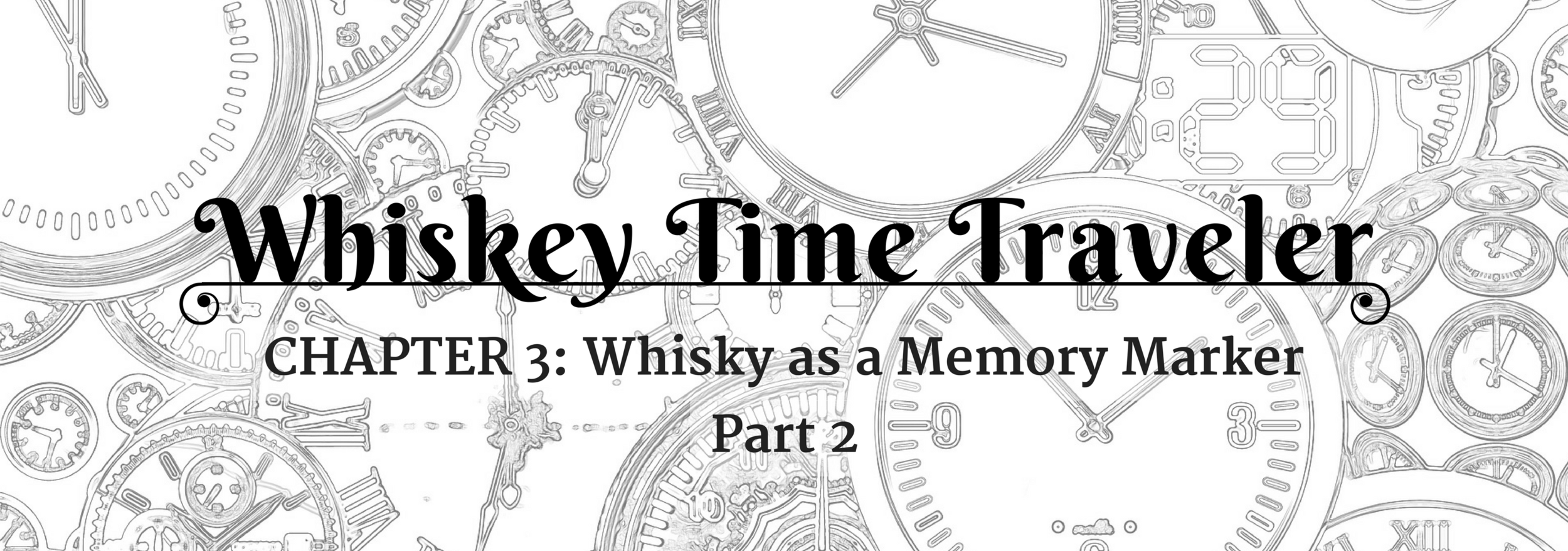Bit by bit we’ve been bringing you parts of the upcoming book, Whiskey Time Traveler by S. Garth Smith. This week we’re happy to present you with chapter 3, part 2. If this is the first you’re hearing of the Whiskey Time Traveler, then check out the previous chapters! Sláinte,
— Zac Smith
CHAPTER 3: WHISKY AS A MEMORY MARKER
Part 2
We’ve identified what a whisky is; now I would like you to start paying attention to the general price range of the whiskies you drink. Whiskies generally start out in price somewhere around $20 a bottle. In the $17 to $28 range, it will be very difficult to find an exceptional whisky. However, you will occasionally run across one in that range that is extremely good for the price. When you do, it will be easier for you to remember that bottle since it didn’t fit in with expectations. When you are talking to friends about whisky you will be able to tell them, “I found a really good bottle of (Bourbon, Rye, Scotch) for $23. You will not be disappointed if you’re looking for an undervalued whisky.”
By the way, a lot of your undervalued Scotch whiskies will be bottled by independent bottlers. Distillers wanting to quickly unload barrels without the expense of bottling and distribution will sell barrels to these bottlers with the understanding that they cannot put the name of the distiller on the label. Everyone wins. You get a good whisky at a better price. The distiller receives an easy cash infusion without lowering their brands price perception. And the independent bottler gets his cut without having to actually own and run a distillery.
The next price level of Whiskies is where you will find most of them. This will be $30 to $60 for Bourbons, Ryes and Irish Whiskies and $45 to around $90 for Scotch and single malts from places like Japan and India.
This is where it becomes a little more difficult to separate and keep track of whiskies. You will certainly find better values in the Bourbons, Ryes and Irish as well as Canadian whiskies but if you’re like me, your tastes may lean more towards the Malts. In later chapters we will discuss how to find your personal taste preferences. For now, know that in this price range there are whiskies that are not worth the price. They have good marketing and because of that they can and do get more for their products than they would be worth in a blind tasting.
Again, there are also some undervalued whiskies here. I found a couple of great ones in this price range. I once paid around $55 for a bottle of Longrow single malt Scotch that could have easily stacked up to any $100 to $150 bottle of Scotch.
Finally we have the over $100 whiskies. When we get together with friends and family that really appreciate a good whisky I don’t mind occasionally pulling out a bottle of Scotch that cost me between $100 and $150. We all enjoy it with respect and remember and tell stories about it for years to come.
Knowing the price range of whiskies is going to help you in selecting a proper whisky for the occasion. If you want a particular occasion to be very memorable, select a pricey whisky and you will not only remember the occasion but also every detail about that bottle of whisky.
Inevitably, when you are talking about a particular whisky, someone will ask, “About how much would that bottle cost?” Here are the three responses you could give depending on the whisky:
- “This is an extremely drinkable whisky for its price. At under $30 a bottle it makes a nice whisky for any day drinking.” Or if you are drinking an independent bottling you could say, “If this had the distiller’s label on it, it would go for closer to $60 to $80 a bottle, but at under $30 I could drink this any day.
- “This bottle will run about ($50 or $60 or $70 or whatever you paid). I enjoy it when I’m looking for something a little different to drink. It really does drink more like a $100 bottle of whisky.
- “This one I only pull out for good friends and special occasions. You don’t want to know how much I paid for it.” Or if you don’t mind revealing the price, simply state, “This one I only pull out for good friends and special occasions. You can find it for between $150 and $200.
There needs to be some ground rules here or these responses won’t work. You do need to know the general price range of the whisky and it’s usually better to understate the price because someone will be looking it up on their phone and know if you are way off base. Also, you do need to be drinking a decent whisky for the money. My goal is to not only teach you how to talk about whisky, but also how to enjoy it. I am always looking to drink a whisky that is undervalued or not yet discovered or if nothing else, one that is priced where it should be. If I am drinking a $30 whisky I want it to taste like a $40 or $50 whisky.
A lot of this is subjective, but believe me, you will know when you’ve overpaid for a whisky. When you are using your $90 whisky for mixed drinks or as your secret ingredient in your cake recipe, you may have overpaid for your whisky. If you find yourself in this situation, laugh about it. Take note of how ridiculously overpriced your whisky was and what you ended up doing with it. Now, you won’t have to feel too bad about where that money could have gone because you just paid for a strong whisky memory marker. You bought a great story and it just so happens that a really bad whisky came with it.
Really good whiskies as well as a really bad whiskies, can make very good destination beacons that we can dial in and aim for when time traveling. However, there are a couple of more little time traveling tricks that we can use to strengthen our whisky memory markers. Let’s take a look at those next.
As the sun rose over the blue waters of Port Charlotte we knew it was going to be a perfect day for touring one of our favorite distilleries. My wife, Lisa and I were traveling with her sister, Gerri and her husband Steve. The four of us make easy traveling companions. The girls had graciously booked a house on Islay for the week. We would visit all eight distilleries on the desolate island. In exchange, we would spend another five days back in Edinburgh, back to civilization, back to Castle touring, fine dining and shopping. We were all happy!
Laphroaig, one of three distilleries on Islay that I refer to as the triplets, not only because they are nearly within walking distance of each other but because to me, they have a more similar taste profile than any of the other distilleries on Islay, Laphroaig is where we started this day. We slipped on a pair of wellies and the four of us along with two others, a father and son from the Netherlands, hopped into the van that would take us up to the water source for the distillery. The “Water to Whisky” tour began at the small loch with its dark water that trickled down to the distillery below. It ended in an intimate tasting room with well-worn leather sofas and chairs. Set before us were four generous drams. Each a different expression of Laphroaig single malt whisky. The first was Laphroaig Triple Wood, aged in two different size casks and then finished in a third sherry cask. The second was Cairdeas, meaning “friendship” in Gaelic, a release that happens once a year of specially selected casks that is first offered to “Friends of Laphroaig” and then to the public. The third was Laphroaig 18 year, a very nice drink. The fourth, an unbelievably smooth 30 year Laphroaig. As we sat and listen to the descriptions of each of the whiskies, my sister-in-law, Gerri had systematically and very quickly progressed from the first one to the last. In each case she took a small sip declaring as she progressed, “I don’t really like this one…This one taste almost the same…This one isn’t as bad.” Until she reached the 30 year. “Oooh, this one I could drink. It’s so smooth.” And in two minutes…it was gone.
You might think that the story ends there but it doesn’t. The next day we popped into the only liquor store that I saw on the entire island. As Steve and I were checking out a couple of really neat independent bottlings, Gerri hollered out from the front of the store, “Steve! Steve!” as she excitedly made her way to where we were standing.
“You didn’t tell me that we were drinking ‘$1500 a bottle’ Scotch yesterday!” She had seen a bottle of Laphroaig 30 year on the upper shelf behind the counter.
“I thought you knew.” Steve replied. “I asked our tour guide how much a dram would cost in a pub and she told us that if you could find it, it would be 70 or 80 pounds or about $150 a shot.”
“If I had known,” Gerri pined, “I would have taken my time and enjoyed it instead of sucking it down so quickly.”
I will never forget the day my sister-in-law threw back a $150 shot of 30 year old Scotch and said, “I could drink this one.”
Time Travel Tips:
- High emotion creates a strong memory marker. Use special occasions or higher priced whiskies to mark places on your timeline that you want to return to and tell stories about.
- Consistency creates a strong memory marker. Find a favorite whisky to enjoy on a relatively consistent basis during routine events in your life.
- Pay attention to the price range of your whiskies. Most will fall into one of three areas; under $30 (some Bourbons, Canadian and Irish whiskies), $30 to $60 (small batch Bourbons and Ryes, really good Irish whiskies and the starting point of some very drinkable Scotch) and $60 to around $100 (plenty of really good whiskies in this range, a majority of Scotch whisky can be found at this price point).
— S. Garth Smith


